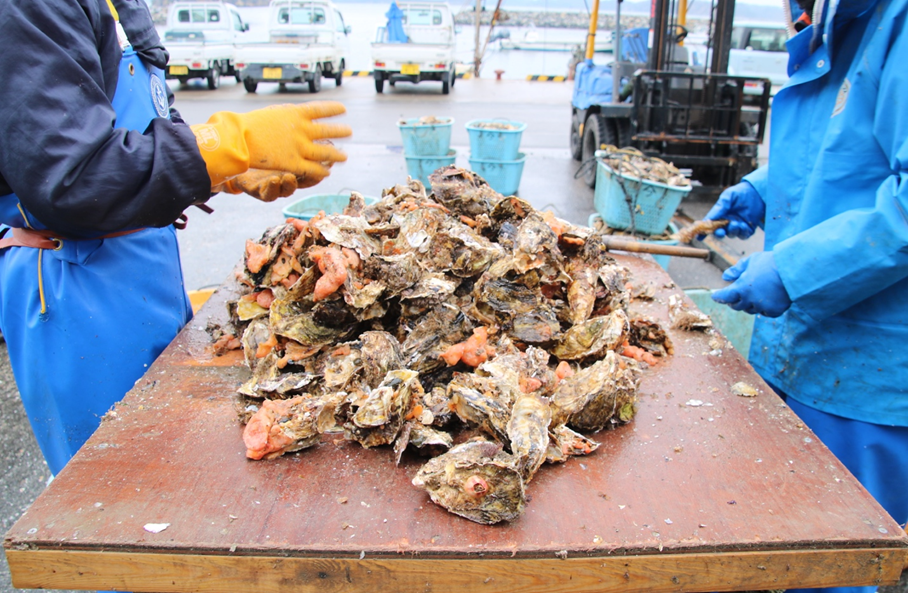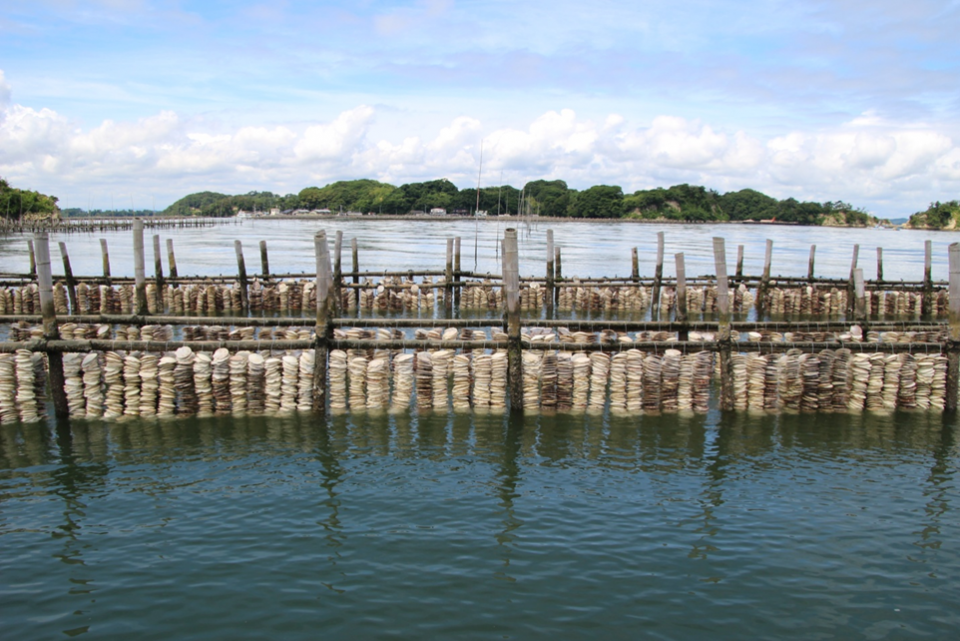While the vast majority of the world’s commercially-produced oysters grow in controlled, land-based hatcheries from spawning until settlement, the method of seed (tane-gaki, known in the industry as “spat”) collection in Japan has been dependent on the wild environment. Miyagi Prefecture, Japan’s second-largest oyster producer, which accounts for more than 50 percent of the national share of seed oysters, has historically played a central role in exporting Pacific oyster (Crassostrea gigas; Magaki) seeds worldwide. Collecting seed oysters in the wild is structured in practice that serves as latent relational potentialities, and thereby encapsulating precarious place-making.

Raft culture in Higashi-Matsushima, Miyagi, enables sessile organisms to attach themselves to oysters.
Raft culture in Higashi-Matsushima, Miyagi, enables sessile organisms to attach themselves to oysters.
Photograph by Mariko Yoshida.
 This work is licensed under a Creative Commons Attribution 4.0 International License.
This work is licensed under a Creative Commons Attribution 4.0 International License.
Local producers’ daily practices have been embedded in a series of acute catastrophic events, such as tsunami and the resulting long-term influence on the coastal environment and biological interactions. When the Tōhoku earthquake occurred in 2011, a tsunami up to twenty meters high caused massive ground sinkage. Oyster-seed producers of Higashi-Matsushima, situated along the east side of Matsushima Bay in Miyagi Prefecture, immediately noticed the land subsidence by sight. The height of their oyster fences, from which seed oysters should be exposed to the sun during low tide, had become lower than before. As a result, the producers reconstructed oyster beds again from the beginning. The rotating allocation of oyster-farming spots is carried out by a ballot every three years, so that farmers ensure the equity of access to multiple farming grounds where the influx of nutrients, via run-off and rivers, varies. Since the earthquake, local farmers have been more rigorously attentive to placing their oyster rafts in the right spots regardless of the existing rotating allocation system designated by a local fishery cooperative association. In addition, they started installing buoys equipped with real-time remote sensors to collect data on the weather and the ocean, including wind, current, tide, and wave intensity at various depths, all of which are used to ensure a controlled environment for oyster production.
It is also notable that unruly multispecies entanglements emerge as a result. As the ebbing tide widened the estuary—which had an impact not only on the salinity of brackish water but also on the entire marine and estuarine ecosystem—deformation caused a change in the circulation of phytoplankton and other such nutrients. While participating in a harvest, I saw a conspicuously orange spongy creature and Mediterranean mussels (shiuri-gai) clinging to two-year-old Pacific oysters. According to one of the local producers, the kinds of species that attach themselves to oysters have changed. Both of these sessile organisms were considered a nuisance since they hindered oysters’ growth. Multispecies parasitic and symbiotic relationships form affective experiences. Unlike other “free-living” bivalves, such as scallops, which are capable of swimming some distance across the sea bed after being released, mature oysters can neither move to find optimum living conditions, nor escape from predators. Their biological immobility, therefore, serves as a fixed-point indicator, helping in the understanding of changes in the local marine ecosystem.

Strings of scallop shells hanging on bamboo oyster fences in Higashi-Matsushima, Miyagi.
Strings of scallop shells hanging on bamboo oyster fences in Higashi-Matsushima, Miyagi.
Photograph by Mariko Yoshida.
 This work is licensed under a Creative Commons Attribution 4.0 International License.
This work is licensed under a Creative Commons Attribution 4.0 International License.
Given the varied trajectories of these environmental disturbances to marine resources, how is the collection of natural oyster spat (ten’nen saibyo) carried out? In Higashi-Matsushima, spat collection in the wild requires skilled knowledge: putting strings of flat scallop shells in the water for larvae, so that the oyster has the opportunity to settle on at the right time. If the oyster farmers suspend them too early, the surface of the scallop shells becomes covered with barnacles and seaweed; consequently, spat collection would be unsuccessful. Spawning of Pacific oysters depends on a rise in water temperature above 18°C. Before microscopic investigation became established, trumpet vine bloom used to be an indicator of the timing of oyster spawning. In early July, local farmers begin collecting samples of swimming oyster larvae in cylindrical-conical plankton nets and measuring changes in water temperature, salinity, and the size of larvae under the microscope, on a rotating basis. Based on these shared data and their own daily inspection at sea, each farmer determines the right timing to suspend collectors to attract oyster larvae. According to their rule of thumb, spat collection is more likely to be successful when the number of barnacle larvae in water samples becomes equal to that of oyster larvae. As such, they describe spat collection in the wild as “gambling,” because their most confident predictions are based on daily climatological data and observations can often go awry. Miyagi producers’ practices of harvesting seed oysters therefore rely on improvisation in the face of unpredictability, as they describe their daily work as “shiodoki-shigoto,” which means that it hinges on day-to-day tidal modality. Moreover, they translocate spat collectors from one grow-out site to another several times, since the optimal oyster seed density varies by destination region.
The case of seed-oyster cultivation in Miyagi demonstrates that interactions, knowledge-making, and biosocial formations are enacted in the aforementioned material-semiotic practices, constituting a landscape of potentialities in which everyday encounters with environmental instabilities and disturbances shape Japanese aquaculture. Seed collection in the wild, as well as the term “ten’nen” (natural), come into being only through comprehensive and integrated actions by human hands, which avoids the standard narratives of the modern nature-culture divide.
How to cite
Yoshida, Mariko. “Seed Oysters in Entangled Worlds: Ecological Disturbances, Knowledge Making, and Potentialities in Miyagi, Japan.” Environment & Society Portal, Arcadia (Autumn 2019), no. 47. Rachel Carson Center for Environment and Society. doi.org/10.5282/rcc/8971.
ISSN 2199-3408
Environment & Society Portal, Arcadia
 This work is licensed under a Creative Commons Attribution 4.0 International License.
This work is licensed under a Creative Commons Attribution 4.0 International License.
2019 Mariko Yoshida
This refers only to the text and does not include any image rights.
Please click on an image to view its individual rights status.
- Gasparri, D. “Oyster Tourism in Postdisaster Japan: Towards an Understanding of Human-Mollusk Relations in the Miyagi Prefecture.” Journal of Ethnobiology 39, no. 2 (2019): 297–314.
- Hasegawa, N., and Tomoko Sakami. “Nihon ni okeru kaki saibyō no henka to shinguru shīdo ten’nen saibyō gijyutu” [Change in oyster seed collection and the emerging single seed technology in Japan], Aquaculture Business, April 2019.
- Lien, Marianne E., and John Law. 2011. “‘Emergent Aliens’: On Salmon, Nature, and Their Enactment.” Ethnos 76, no. 1 (2011): 65–87.
- Swanson, H. “Methods for Multispecies Anthropology.” Social Analysis 61, no. 2: 81–99. Retrieved 9 July 2019.
- Wilhelm, J. H. “Seven Years after Disaster: Fisheries Communities in Coastal Pacific Tōhoku.” In Small-scale Fisheries in Japan: Environmental and Socio-cultural Perspectives, edited by G. Bulian and Y. Nakano, 129–52. Venice: Edizioni Ca’ Foscari, 2018.








